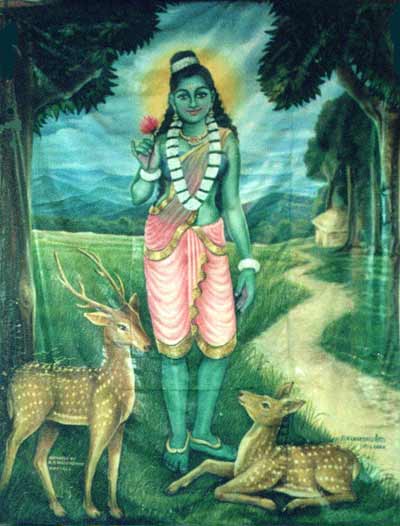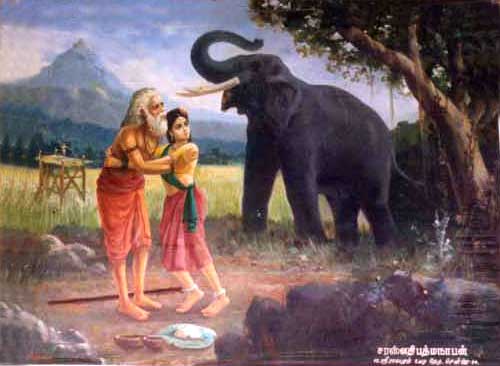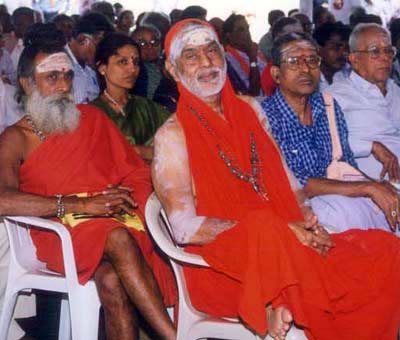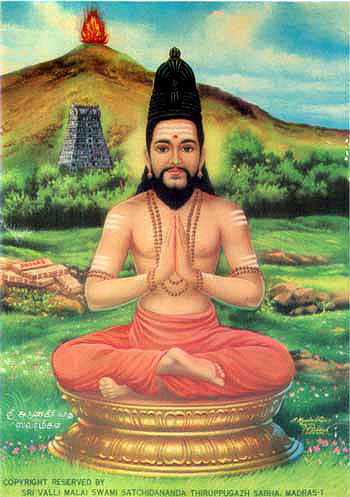
|
||||||||||
|
| ||||||||||
Saint Arunagirinathar: Was he a Śakta?
Original Tamil text by Sadhu Ram
|
 |
Śrī Arunagirinatha explains that the One Supreme Brahman became manifested as so many different deities. He makes it clear that those who worship Lord Muruga externally worship only the Para Brahman. Of the six principal deities of the six systems of worship founded by Śrī Sankara, five of them are male gods and only one is a female. If we make a deep study of the itihasas and puranas, we will find that the female aspect of God -- Para Śakti -- is the source of energy to all male gods. Therefore, whichever god we worship, we worship Śakti in addition and it is this Śakti who is the principal deity of the Śakta cult. She is called by many names, as Ambika, Devi, etc.
This self-same Śakti manifests as various forms of Gods in all different forms of worship. But whenever we worship the female aspect of any god, we worship Her only. Abhirama Bhattar worshipped Śakti as the All-pervading Force in the universe. It is She who performs the tasks of creation, protection and destruction.
Without that energy or Śakti, even the great deities like Brahmā, Vishnu and Śiva are powerless as stated in the Lalita Sahasranama. Not only the Trinity, but the other gods and devas also like Lord Ganesha, Lord Muruga, Sun, Moon, Indra, Manmatha, and Kubera and sages like Agastya and Durvasa are stated to be worshippers of Śakti. From this it is clear that all the deities worship Para Śakti and derive their energy from Her to perform their respective tasks. Therefore, when devotees worship gods, they worship only Para Śakti in truth. In this sense, all the devotees of different cults may be called Śaktas and it is no surprise if we call Arunagirinatha as a Śakta.
By the grace bestowed by Devi, Śaktas claim the ultimate experience of Nirguna Brahman by their worship of Para Śakti in its external form or Saguna Upasana. This is the greatness inherent in Śakti worship. It is not necessary that one who worships Śakti internally should worship Her in the external form as well. Similarly, there is no bar on those who worship other deities in the external form from worshipping Her internally. We are of the opinion that, though Arunagirinatha worshipped Lord Muruga in many of his songs, he worshipped only Devi internally in his heart and he may, therefore, be called a Śakta. We may also take note that many other saints besides Arunagirinatha finally became upasakas of Devi or Śaktas in their heart of hearts, though they had first started with external worship of Lord Muruga or Lord Krishna.

|
|
At that moment, Murugan invoked the help of his brother Vināyaka who appeared behind Valli in the shape of a frightening elephant. The terror-stricken girl rushed into the arms of the Saiva ascetic for protection. Painting from Tiruttani Devasthanam. |
We may now examine some of the ideas of Arunagirinatha in his compositions as further proof that he was a Śakta:
He reveals in the Kandar Anubhuti that Devi incarnated in the world in Poorna Nakshatra for the uplift of mankind. In some other songs of his Tiruppukal, he describes Devi of being green in complexion. In another Tiruppukal, he describes the divine vehicles of Devi. Arunagirinatha says that Devi had incarnated at innumerable times for the benefit of mankind. He describes several holy places where Devi had incarnated and extols the great sanctity of such places.
Śrī Arunagirinatha declares that not only gods and great saints but ordinary mortals also have worshipped and obtained the grace of Devi. He believes that the reason for such unique greatness of Devi is that She is the very personification of the Vedas. He has referred to the worship of Devi in the vamachara form also, thereby showing his familiarity with various rituals pertaining to that worship. It will be quite an experience to go through the works of Arunagirinatha showing his wide knowledge and experience of Śakti worship in all its respects. This great joy of Devi Upasana, he has disclosed to us in many of his Tiruppukal.
We will now consider the nātha title of Śrī Arunagirinatha and some of the events in his life to strengthen our view that he was a Śakta. The title nātha is normally conferred on one when he becomes an adept in the worship of Devi. Saint Agastya was initiated into the worship of Devi by Lord Hayagriva and was considered as a great devotee of Devi. The title nātha was, therefore, conferred on him and also on Śrī Tirumoolar, who was one of the twelve disciples of Agastyanatha.
It can be easily seen from the works of both these saints that they were Śaktas. Though Saint Tirumoolanatha worshipped Lord Śiva externally, he was a Śakta in his internal worship. There are great similarities between Saint Arunagirinatha and Saint Tirumoolanatha. Arunagirinatha has adopted several ideas from Tirumoolanatha. From the very title nātha conferred by Lord Muruga on Arunagiri, we can infer that he was a Śakta.
 |
Sadhu Ram (center) with friends and disciples at the First International Conference on Skanda-Murukan |
We may now see some of the experiences of Arunagirinatha with Devi as found in his works. He has said that Devi had removed his ignorance, sufferings and desires, destroyed his ego and showered Her grace on him and that She was his Mother and Protector at the time of his death. when Arunagirinatha externally worships the same Śakti like Lord Muruga himself, he prays to Śrī Valli to come along with Him and give darshan. He records how Śrī Valli has blessed him with sparsa diksha, which removed the effects of his karma.
There are many references in Arunagirinatha's songs in which he has extolled Śrī Valli as greater than Muruga. In his descriptions of Lord Muruga's associations with Valli, Lord Muruga is made to say that He will not worship any other woman than Valli. He goes to the millet fields of Vallimalai to offer His salutations to the Golden Hunter Girl. He walked on thorns and rocks of the Vallimalai Hill, seeking the young hunter woman. He brought sheaves of leaves for the Śakti -- the Royal Hunter Girl -- to fashion a dress for Her. He spent all his time without any other thought in Valli's company. He became an errand boy of Valli.
Lord Muruga was the Divine Suitor and companion to her Excellency the Hunter Girl, the Lover and bodyguard of Valli. He declared that He was Her slave for all time and had it so inscribed on Mount Meru, witnessed by the devas. He massaged Her feet; His head is often decorated by bowing down to Valli's feet. He grasped the feet of Valli treating it as the Seed of the Pranava mantra. Śrī Arunagirinatha has worshipped Śrī Valli and has referred to the method of Śakta worship by which the husband worships his wife as the World Mother or Para Śakti. This is the inner meaning of Lord Muruga's worship of Śrī Valli.
Note by Swami Anvananda:
One who is seeing a picture in a cinema, forgetting for the time how it is produced and projected, experiences the joys and sorrows caused by its semblance to real life. This forgetfulness will recur again and again unless he becomes the producer or one of the principal actors absorbed in the technique of acting under conditions true to life and nature within the studio. Every jñāni or comprehensor, therefore, becomes a Śakta in the end when he tries to understand the manifestation of the universe as the play or sport of Devi.
To Arunagirinatha, Muruga, who married Valli or Iccha Śakti, became Her companion in the sport and Her slave or actor when participating in the play of which She is the Director. The Śakta cult, therefore, teaches that there is One Reality and nothing besides which is false or illusory to true knowledge and understanding.
Sadhu Ram Swamigal was a direct and beloved disciple of Śrī Vallimalai Tiruppukal Saccidananda Swamigal. He traveled almost constantly at the invitation of Murukan devotees across much of Tamil Nadu until his untimely passing in April 2000.
